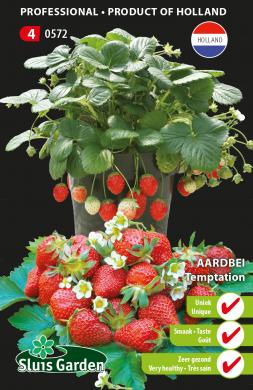1
/
of
1
Strawberry semi-large fruited temptation
Strawberry semi-large fruited temptation
Regular price
1.550 KWD
Regular price
Sale price
1.550 KWD
Unit price
/
per
Shipping calculated at checkout.
Couldn't load pickup availability
Growing strawberries, especially the semi-large fruited variety like 'Temptation,' can be a rewarding experience. Here's a guide on how to grow Strawberry 'Temptation':
**1. Choosing the Right Variety:**
- Start by selecting a quality 'Temptation' strawberry plant from a reliable nursery or garden center.
**2. Planting Time:**
- Plant strawberries in early spring or late summer, depending on your local climate.
**3. Site Selection:**
- Choose a location with well-drained soil that receives full sunlight. Strawberries also prefer slightly acidic to neutral soil.
**4. Planting Method:**
- Plant 'Temptation' strawberries from bare-root plants or runners. Ensure the crown is just above the soil level, and the roots are spread out. Space the plants about 12-18 inches apart in rows that are 2-3 feet apart.
**5. Soil Preparation:**
- Prepare the soil by incorporating organic matter such as compost. Well-amended soil provides the necessary nutrients for healthy strawberry plants.
**6. Watering:**
- Strawberries need consistent moisture, especially during flowering and fruiting. Water deeply to ensure the soil remains evenly moist. Avoid overhead watering to reduce the risk of fungal diseases.
**7. Mulching:**
- Apply a layer of straw or pine straw around the plants to suppress weeds, retain soil moisture, and keep the strawberries clean. Mulching also helps prevent soil-borne diseases.
**8. Fertilizing:**
- Fertilize strawberries with a balanced fertilizer or one specifically formulated for berries early in the growing season. Follow the recommended rates on the fertilizer package.
**9. Runners and Daughter Plants:**
- 'Temptation' strawberries produce runners, which are long stems with small plants at the end. Allow some runners to establish new plants for the next season, but too many runners can reduce fruit production. Trim excess runners to focus plant energy on fruiting.
**10. Protection from Birds:**
- Birds are attracted to ripe strawberries. Consider using bird netting or other protective measures to prevent birds from eating your harvest.
**11. Disease and Pest Management:**
- Keep an eye out for common strawberry pests such as aphids and spider mites. Address any pest issues promptly. Additionally, watch for signs of fungal diseases, and provide adequate spacing and ventilation to reduce the risk.
**12. Harvesting:**
- Harvest 'Temptation' strawberries when they are fully red and ripe. Pick the berries with their green caps attached. Harvesting is usually done in the morning when the berries are cool.
**13. Winter Care:**
- In colder climates, protect strawberry plants during the winter by mulching with straw. This helps insulate the plants and prevents winter damage.
**14. Renewal and Replacement:**
- Strawberry plants tend to decline in productivity after a few years. Consider renewing your strawberry bed by replanting with new, disease-free plants every 3-5 years.
Always follow the specific recommendations provided by the supplier or on the plant tag for 'Temptation' strawberries. Adjust care based on your local climate and growing conditions.
**1. Choosing the Right Variety:**
- Start by selecting a quality 'Temptation' strawberry plant from a reliable nursery or garden center.
**2. Planting Time:**
- Plant strawberries in early spring or late summer, depending on your local climate.
**3. Site Selection:**
- Choose a location with well-drained soil that receives full sunlight. Strawberries also prefer slightly acidic to neutral soil.
**4. Planting Method:**
- Plant 'Temptation' strawberries from bare-root plants or runners. Ensure the crown is just above the soil level, and the roots are spread out. Space the plants about 12-18 inches apart in rows that are 2-3 feet apart.
**5. Soil Preparation:**
- Prepare the soil by incorporating organic matter such as compost. Well-amended soil provides the necessary nutrients for healthy strawberry plants.
**6. Watering:**
- Strawberries need consistent moisture, especially during flowering and fruiting. Water deeply to ensure the soil remains evenly moist. Avoid overhead watering to reduce the risk of fungal diseases.
**7. Mulching:**
- Apply a layer of straw or pine straw around the plants to suppress weeds, retain soil moisture, and keep the strawberries clean. Mulching also helps prevent soil-borne diseases.
**8. Fertilizing:**
- Fertilize strawberries with a balanced fertilizer or one specifically formulated for berries early in the growing season. Follow the recommended rates on the fertilizer package.
**9. Runners and Daughter Plants:**
- 'Temptation' strawberries produce runners, which are long stems with small plants at the end. Allow some runners to establish new plants for the next season, but too many runners can reduce fruit production. Trim excess runners to focus plant energy on fruiting.
**10. Protection from Birds:**
- Birds are attracted to ripe strawberries. Consider using bird netting or other protective measures to prevent birds from eating your harvest.
**11. Disease and Pest Management:**
- Keep an eye out for common strawberry pests such as aphids and spider mites. Address any pest issues promptly. Additionally, watch for signs of fungal diseases, and provide adequate spacing and ventilation to reduce the risk.
**12. Harvesting:**
- Harvest 'Temptation' strawberries when they are fully red and ripe. Pick the berries with their green caps attached. Harvesting is usually done in the morning when the berries are cool.
**13. Winter Care:**
- In colder climates, protect strawberry plants during the winter by mulching with straw. This helps insulate the plants and prevents winter damage.
**14. Renewal and Replacement:**
- Strawberry plants tend to decline in productivity after a few years. Consider renewing your strawberry bed by replanting with new, disease-free plants every 3-5 years.
Always follow the specific recommendations provided by the supplier or on the plant tag for 'Temptation' strawberries. Adjust care based on your local climate and growing conditions.
Share

